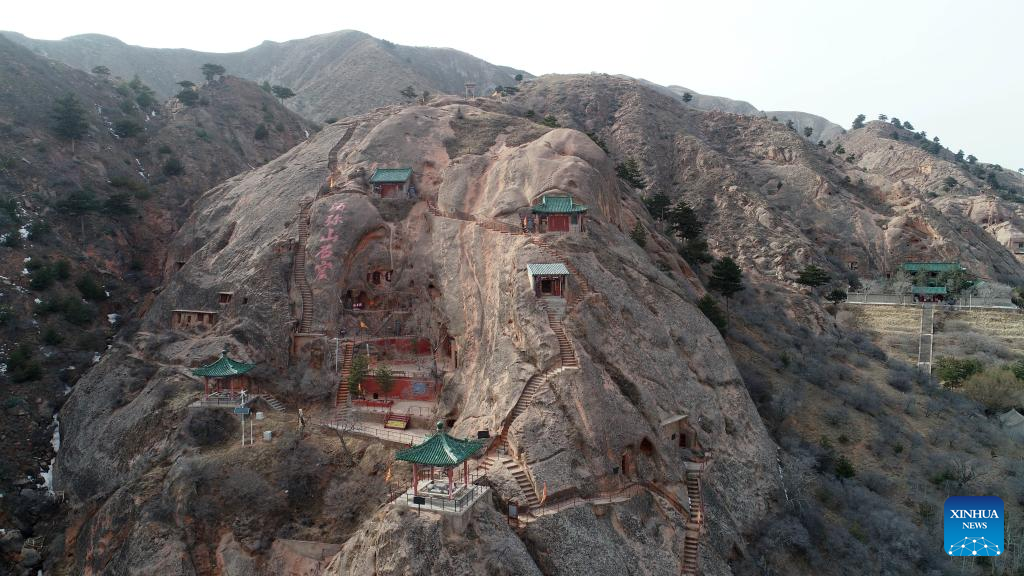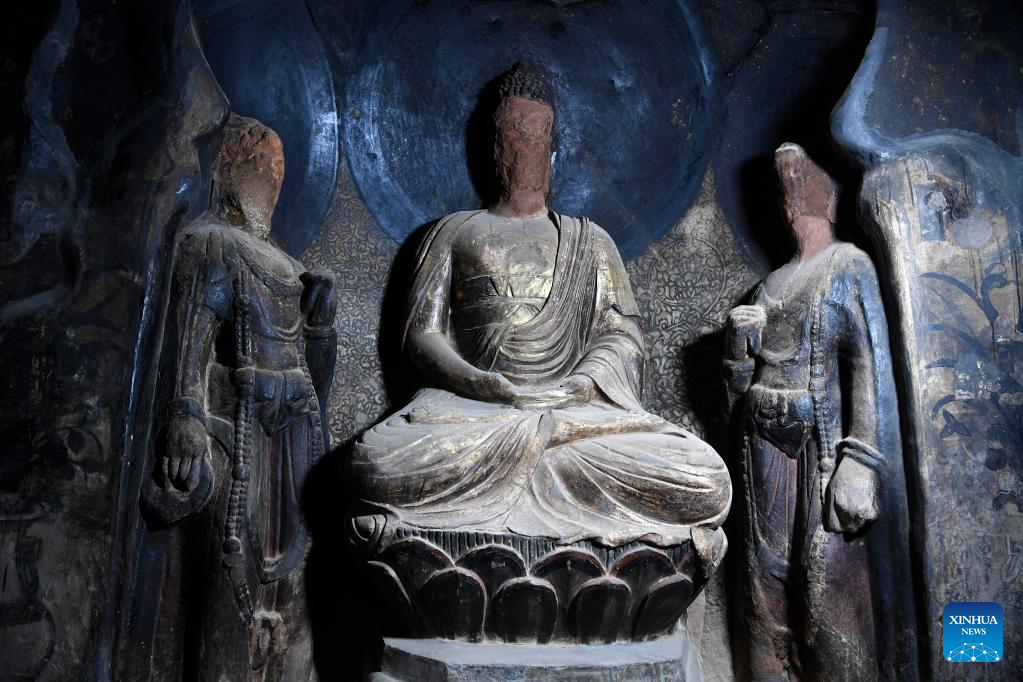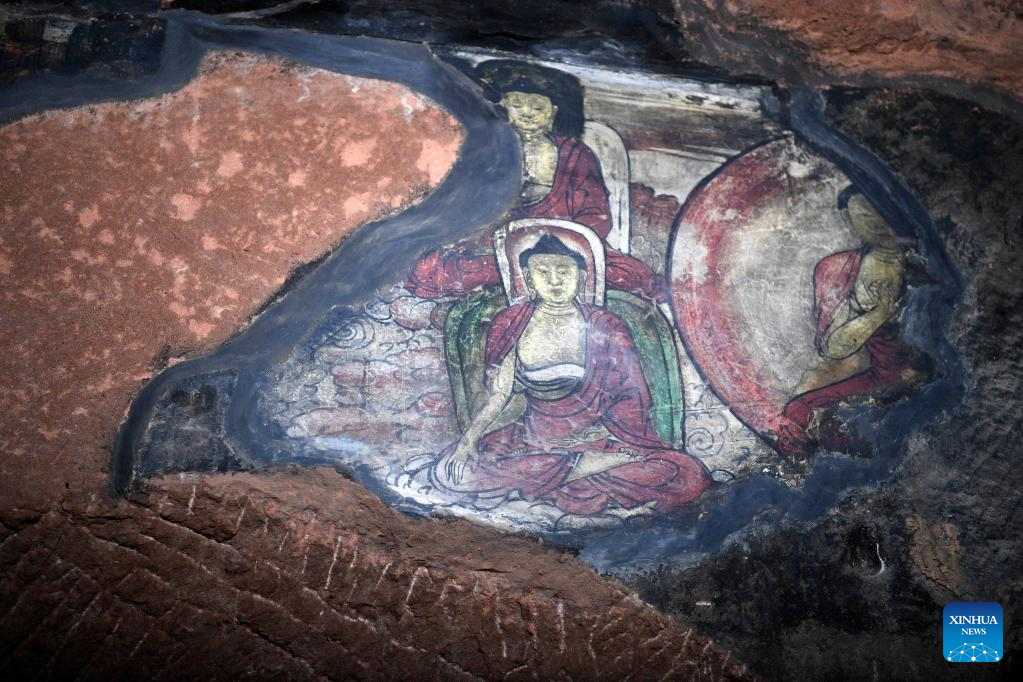


This aerial photo taken on Feb. 28, 2023 shows an exterior view of the Xumishan Grottoes, initially built in the late period of the Northern Wei Dynasty (386-534), in Guyuan, northwest China's Ningxia Hui Autonomous Region. (Xinhua/Wang Peng)
YINCHUAN, March 12 (Xinhua) -- Cheng Yaodong, a part-time tourist guide, has told hundreds of tourists about the history and folklore of Xiaoguan Pass in Liupanshan Mountain, northwest China's Ningxia Hui Autonomous Region.
"Although the exact location of Xiaoguan Pass has always been disputed by historians, we are certain that it served as a military fortress and an important stop on the Silk Road during the Tang Dynasty (618-907) in the Guyuan region of southern Ningxia," said Cheng.
The Silk Road had been a vital corridor connecting the East and West since the Han Dynasty (202 BC-220 AD) about 2,000 years ago. Its name was derived from the lucrative trade in Chinese silk carried along the route. It was significant for trade and culture and brought civilization and prosperity to cities and towns along its network.
Cheng, 50, is a staff member of Ningxia Liupanshan Tourism Group Co., Ltd. in Guyuan, one of the cities that witnessed the history of the Silk Road. He also likes to present tourists with ancient poetical works on the subject of Xiaoguan Pass.
These poems told stories of the homesickness of the soldiers posted there, the eagerness of the merchants to return home and the beauty of the frontier scenery.
Liupanshan Tourism Group is a government-run tourism company promoting local life in southern Ningxia to tourists by tapping the Silk Road culture. It arranges tours for over 1 million visitors each year.
In 2005, a park modeled after the ancient Xiaoguan Pass was built 36 kilometers south of Guyuan City, where tens of thousands of visitors have left their footprints ever since.
"Tourism helps people better understand Guyuan's role in the history of the Silk Road and the rich culture it has developed over some 2,000 years of interaction with ethnic groups and foreign merchants," said Cheng.
About 55 km north of Guyuan City lies another Silk Road tourist attraction, the Xumishan Grottoes. It draws hundreds of visitors weekly, although still under restoration, with its 20-meter-high Buddha statue shielded by scaffolding.
Nearly three years ago, cultural relics experts across China began a restoration project on murals in the Xumishan Grottoes dating back over 1,500 years. The restoration project is still in progress.
The Xumishan Grottoes, initially built in the late period of the Northern Wei Dynasty (386-534), make up 162 caves and more than 1,000 Buddha statues. The area was listed as a key state-level cultural site in 1982.
Located on the northern road of the eastern section of the ancient Silk Road, the Xumishan Grottoes is one of China's top ten grottoes sites. It was listed by the World Monuments Fund as one of the 100 most endangered architectural and cultural sites in the world in 2007.
"The grottoes, known by many as 'the Pearls of the Silk Road,' contain a whole set of cultural heritage, including Buddhist sculptures, murals, temple buildings, ancient trees, Danxia landform, and strange stones," said Wang Xi, head of the cultural relics management bureau of Xumishan Grottoes.
The Xumishan museum at the foot of the mountain focuses on the Silk Road and Buddhist artwork, demonstrating the history of the Silk Road in China, the historical position of Guyuan on the Silk Road, and the history of Buddhism's entry to China via the Silk Road.
"By popularizing the ancient Silk Road culture, we have promoted local tourism and boosted the economy," Wang said. ■

This photo taken on Feb. 28, 2023 shows restored Buddha statues in the Xumishan Grottoes, initially built in the late period of the Northern Wei Dynasty (386-534), in Guyuan, northwest China's Ningxia Hui Autonomous Region. (Xinhua/Wang Peng)

This photo taken on Feb. 28, 2023 shows a restored mural in the Xumishan Grottoes, initially built in the late period of the Northern Wei Dynasty (386-534), in Guyuan, northwest China's Ningxia Hui Autonomous Region. (Xinhua/Wang Peng)
点击右上角![]() 微信好友
微信好友
 朋友圈
朋友圈

请使用浏览器分享功能进行分享
